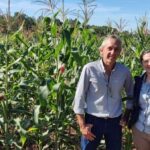Global Courant 2023-05-04 03:14:11
The ban on single-use plastic products is crucial in this respect Canada’s plan to achieve zero plastic waste by 2030but with the ban, environmentalists are increasingly concerned about the amount of paper packaging used instead.
“We definitely need to get rid of plastic, but trading plastic pollution for deforestation and forest degradation is not the answer,” Canopy founder and executive director Nicole Rycroft told CTV News. “We really need to make sure we don’t cause another environmental disaster.”
from Rycroft non-profit organisation works to protect the world’s forests by helping companies like Walmart and H&M ensure their packaging is paper free and environmentally friendly.
She estimates that more than three billion trees are cut down each year, many of which are old and endangered, to make paper-based products such as bags, straws and food containers.
“We are seeing a wave of global bans on single-use plastics, including here in Canada, and with paper quickly replacing these products, the pressure on the world’s forests is increasing.”
Canada’s ban on single-use plastics, which took effect in December 2022, prohibits the manufacture and import-for-sale of products ranging from checkout bags and cutlery to take-out containers and stirrers.
With the ban, consumption of single-use plastics has begun to decline, but in many cases those products have been replaced by paper alternatives. Rycroft points to supermarkets, which now provide paper bags at checkout, as an example.
“I think everyone is aware of the saying that forests are the lungs of our planet and so this is a really critical moment and we need to take steps to keep forests afloat, rather than putting pressure on them to supply the fibers for bags, pizza boxes, cutlery and straws.”
In addition to concerns about increasing deforestation, there are concerns about the large amounts of energy and water needed to make paper products.
The Netherlands-based and UN-supported Institute for Water Education says it can take between two and thirteen gallons of water to make a standard piece of paper.
Another potential problem with single-use paper products is the harmful impact they have if they end up in landfills.
“It is believed that because paper is a natural product it will be better, but if it ends up in a landfill it could become a real problem,” says Calvin Lakhan, environmental and urban change researcher at York University .
Lakhan is an expert in waste management and co-founder of Waste Wikia project that “seeks to bridge the gap between academia, industry and government on waste issues”.
While paper is more biodegradable and easier to recycle than plastic, he notes that the quality of the paper often determines whether or not it can go into the recycling system.
“Things like newsprint are easily recycled, but certain products, like the bags you get from McDonald’s, won’t be able to be reprocessed and sorted in the same way because they’re of a lower grade of paper.”
Lakhan adds that while paper can be composted in a landfill, the decomposition process releases greenhouse gases, which he says negates the benefits of using it.
“When paper or other organic material ends up in our landfill and decays, it releases methane, which is so much worse for the environment.”
While paper is not perfect, the industry is working on innovative solutions, including using agricultural waste or other plant material such as straw to make pulp.
In Canada there are more than 20 million hectares of arable land were used to produce wheat, but after the grain is harvested, farmers are left with straw stalks stuck in their fields. While the material has traditionally been considered waste, Rycoft says some companies are trying to give it a new lease of life by turning it into single-use packaging.
Straw is used together with hemp, flax, tomato stems and banana peels to make sustainable single-use products.
“Next-gen products made from things like straw are already mainstream in places like China and India,” Rycroft said. “There is an opportunity for Canada to follow suit and become a leader in next-generation low-carbon packaging.”
There are also biodegradable resins used to make bags and tableware. The challenge with these new innovations, however, is that many of them are expensive to produce and often only have niche applications.
With that, Lakhan says it’s essential that waste policies and procedures continue to evolve from “a single-use model, be it paper or plastic.”
In addition, he encourages consumers to explore what they can do to make a difference, particularly by opting for reusable packaging whenever possible.
“When consumers rethink and reorient themselves to a reusable mindset, it will ultimately lead to the most sustainable outcomes.”




